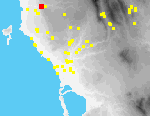 M03
Valta Ayios Georgios
M03
Valta Ayios Georgios
Tile: Ott-EMod, Mod
The site lies on a flat-topped knoll-marked by a modern church of Ayios Yioryios and a trigonometric point (253 masl)[088.23][088.20]-overlooking the Lagkouvardos Gorge immediately to the S[088.27]; the village of Valta lies ca. 700 m. to the NE. The top of the hill is an open fallow field, sloping away gently to the N, where it is terraced although today uncultivated. To the NE (in the direction of Valta) the hill drops more steeply onto stone-built terraces. To the S and E a steep maquis-covered slope falls (some 60-80 m.) to an olive-covered plateau before plunging vertically to the gorge bottom. To the W is an even steeper maquis-covered slope offering spectacular views of the coastal plain.
Material from the site included datable Turk-EMod ceramics, but there were also significant quantities of hand-made coarse ware and glazed tiles, although neither class seems chronologically distinctive.
Agios Yioryios produced a small quantity of ceramic material, consisting mainly of large fragments of tile and coarse ware body sherds. Very little of this material was chronologically diagnostic. Turkish to Early Modern glazed wares [(4 sherds in squares 3781, 3801, 3811)] are the only narrowly datable pottery. The majority of pottery collected from the site consists of handmade sherds in a distinctive coarse ware fabric, which is orange with large tan clay inclusions A well attested local MH III-LH II coarse ware fabric has similar clay inclusions, but the fabric from this site is finer, and the inclusions harder and more angular. At this point, the fabric cannot be dated.
The tile falls into three categories. Most of the tile (57 fragments) is not precisely datable but may be Turkish to Early Modern. Other tile [found in squares 3781, 3782, 3801, 3811, and 3812] is clearly Modern (32 fragments). A problematic factor at this site is a group of 17 tile fragments [found in squares 3781, 3782, 3791, 3801, and 3812], which are glazed but do not seem typical for ancient tile either in their dimensions or their fabric. The fabric is heavy with numerous large inclusions, essentially pithos fabric, and the tiles are much thicker than most ancient painted tiles.